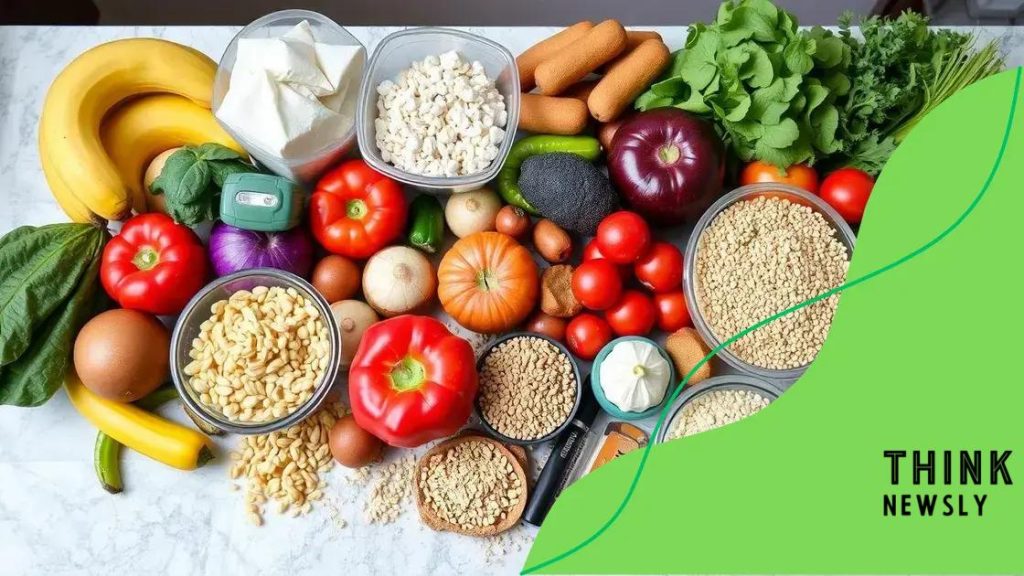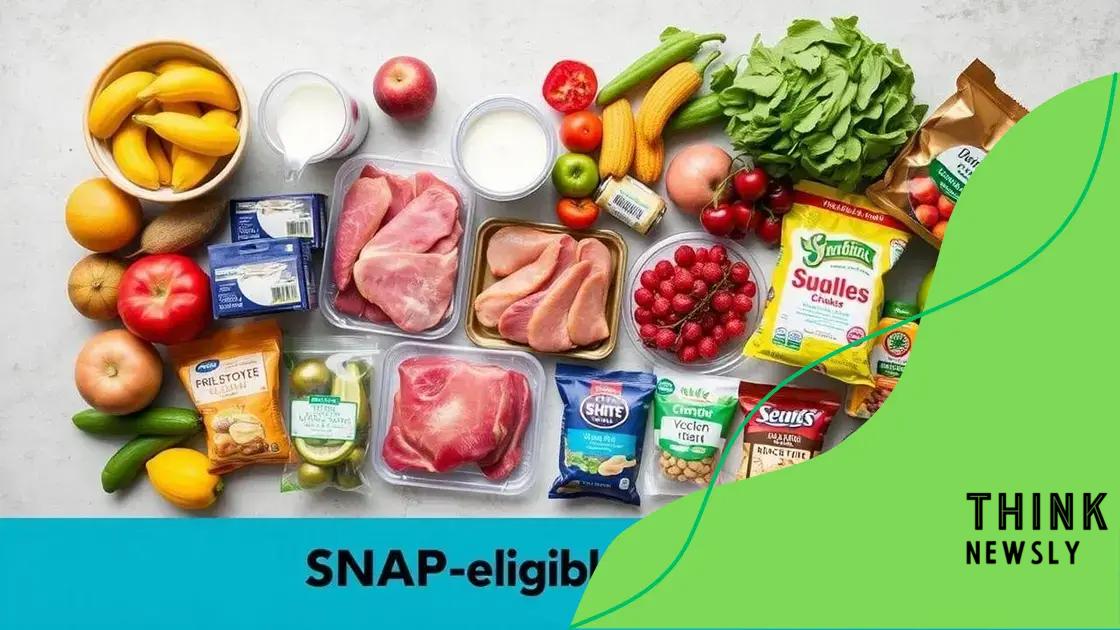SNAP covers more food types than you think

Anúncios
SNAP covers a variety of nutritious food options, including fruits, vegetables, meats, and dairy products, supporting low-income families in accessing healthy meals.
SNAP covers more food types than you might expect, providing access to a variety of nutritious options. Have you ever wondered how these benefits can enrich your meals and improve your diet? Let’s dive into the diverse offerings of SNAP.
Anúncios
Understanding SNAP and its purpose
The Supplemental Nutrition Assistance Program (SNAP) is designed to help families and individuals access healthy food. Understanding how SNAP works is important for those seeking assistance. It provides benefits to low-income households, ensuring they can purchase food and maintain proper nutrition.
The Purpose of SNAP
SNAP aims to alleviate hunger and improve nutrition among eligible participants. This program supports families in need by providing financial assistance for purchasing food. It focuses on nutrition education as a part of its mission, encouraging healthy eating habits.
How SNAP Works
Participants receive a monthly benefit, which can be used like cash at grocery stores. Benefits are loaded onto an Electronic Benefits Transfer (EBT) card, which makes it easier and more discreet to shop. It covers a wide range of food items, including:
Anúncios
- Fruits and vegetables
- Meat and poultry
- Dairy products
- Breads and cereals
SNAP also emphasizes the importance of making nutritious choices. By doing so, it helps to address food insecurity and promote better health outcomes. Many people don’t realize that SNAP covers more food types than just basic items. Understanding this can lead to better meal planning and healthier eating.
Moreover, SNAP benefits can be combined with other resources to further assist families. Local food banks often work hand-in-hand with the SNAP program to provide additional support and food options. This collaboration enhances the effectiveness of the program, ensuring families have access to the nutrition they need.
Understanding SNAP also involves recognizing its impact on the community. When families receive benefits, they can spend more in local grocery stores. This helps to boost the economy while ensuring that households have sufficient food on their tables.
In summary, the SNAP program is a vital tool in the fight against hunger. By providing essential support and education, it helps eligible families lead healthier lives and contributes positively to their communities.
Types of food covered by SNAP
The SNAP program covers a variety of food items, ensuring that participants can maintain a balanced and nutritious diet. Knowing the types of food eligible for purchase can help beneficiaries make informed choices.
Fruits and Vegetables
Fruits and vegetables are essential for a healthy diet. SNAP benefits allow participants to purchase fresh, frozen, and canned varieties. Aim for diverse colors and types to maximize nutrients.
- Fresh fruits like apples, oranges, and bananas
- Fresh vegetables such as spinach, carrots, and broccoli
- Canned options, which can be convenient
Incorporating fruits and vegetables into meals can boost overall health, and SNAP supports this by providing access to these vital foods.
Meat and Dairy Products
Participants can also buy various meat and dairy products. This includes options like:
- Fresh meat, poultry, and fish
- Eggs
- Milk, yogurt, and cheese
These items are important for protein and calcium intake. By utilizing SNAP benefits wisely, families can ensure they receive the essential nutrients these foods provide.
SNAP also covers snacks and further processed items, as long as they are food products. Eligible items include:
- Granola bars
- Frozen pizzas
- Cereal
Beneficiaries can buy these foods too. Understanding SNAP’s coverage allows families to broaden their diet and explore various cuisines.
It’s important to note that cooked foods and supplements typically are not covered. However, with the wide range of eligible items, families can experiment and enjoy flavorful, nutritious meals.
Exploring eligible items for purchase

Exploring the eligible items for purchase with SNAP benefits is key for maximizing nutrition and budgeting effectively. Participants can choose a wide variety of foods that support a healthy lifestyle.
Grocery Store Essentials
Most grocery stores accept SNAP benefits, allowing users to buy essential food items. This includes:
- Fresh fruits and vegetables
- Meat, poultry, and fish
- Dairy products
- Breads and cereals
These staples form the foundation of any balanced meal and are crucial for maintaining good health.
Snacks and Beverages
SNAP also covers certain snacks, which can help with energy throughout the day. Eligible items include:
- Granola bars and protein bars
- Chips and popcorn
- Sodas and juice
While these items can be part of a healthy diet, it’s important to consume them in moderation. Including a mix of snacks can keep meal times interesting without sacrificing nutrition.
Additionally, SNAP benefits cover specific prepared foods and meals, as long as they are sold in grocery stores. This includes frozen dinners and meal kits. However, it does not cover hot, prepared foods from restaurants, which limits some dining options. Understanding what you can buy helps in planning meals and ensures you take full advantage of the program.
With SNAP, participants can also purchase seeds and plants to grow their own food. This option encourages healthier eating habits and can be rewarding for families as they cultivate their own fruits and vegetables.
In summary, the flexibility of SNAP eligible items allows for diverse meal options while promoting health and wellness.
How to best utilize SNAP benefits
Knowing how to best utilize SNAP benefits is essential for maximizing the support it offers. By making informed choices, participants can stretch their resources further and improve their overall nutrition.
Plan Your Meals
One effective strategy is to plan your meals for the week. This can help you make smart shopping decisions and avoid impulse buys. Start by creating a list based on your meal plan, and stick to it when shopping. Consider these tips:
- Choose recipes that use similar ingredients to minimize waste.
- Create a shopping list based on your meal plan.
- Look for sales and discounts on items you need.
Meal planning not only saves money but also ensures that you have healthy options ready to eat.
Stock Up on Staples
Buying staple items in bulk can also be a smart way to utilize SNAP benefits effectively. Some staples include:
- Rice and pasta
- Canned goods, like beans and tomatoes
- Frozen vegetables
These items have a long shelf life and can be used in many recipes, making them perfect for a well-stocked pantry. By focusing on staples, you can create a variety of meals without breaking the bank.
Additionally, consider utilizing local farmers’ markets. Many markets accept SNAP benefits, allowing you to buy fresh produce at reasonable prices. This can not only support local farmers but also enhance your diet with seasonal fruits and vegetables. It’s another way to make the most of your benefits while enjoying fresh, delicious food.
Another beneficial approach is to use the resources available through SNAP, such as nutrition education programs. These programs can give you tips on how to cook nutritious meals on a budget. Engaging with local workshops or online resources can greatly enhance your cooking skills and make meal preparation a fun activity.
Incorporating these strategies can help ensure that you are making the most out of your SNAP benefits, promoting not only a healthy diet but also financial well-being.
Common misconceptions about SNAP
There are many common misconceptions about the Supplemental Nutrition Assistance Program (SNAP) that can lead to confusion and stigma. Understanding these myths can help clarify the true purpose of the program.
Myth: SNAP is only for the unemployed
One major misconception is that SNAP benefits are exclusively for unemployed individuals. In reality, many working families use SNAP. This program assists those with low incomes, regardless of their job status.
Myth: SNAP benefits are unlimited
Another myth is that SNAP benefits provide an unlimited supply of food. In fact, benefits are calculated based on household size and income. Each family receives a specific amount, designed to supplement their food needs, not cover all expenses.
Myth: Only processed foods can be purchased
Many people believe that SNAP can only be used to buy unhealthy, processed foods. This is not true. SNAP benefits can be used to purchase a wide variety of foods, including fresh fruits, vegetables, whole grains, and dairy products. Participants can use benefits to buy items that promote healthy eating.
Furthermore, there’s a misunderstanding that SNAP recipients only misuse their benefits. Most participants use their benefits responsibly, aiming to provide healthy meals for their families. It’s essential to challenge these stereotypes to support a more inclusive community.
It is important to educate others about the realities of SNAP. Sharing accurate information can help reduce stigma and encourage those who qualify to seek assistance without fear of judgment. Engaging with your local community and participating in discussions can bring about positive change.
FAQ – Frequently Asked Questions about SNAP Benefits
What is SNAP and who can apply for it?
SNAP, or the Supplemental Nutrition Assistance Program, helps low-income individuals and families buy nutritious food. Anyone meeting income eligibility can apply.
Can I use SNAP benefits to purchase prepared foods?
No, SNAP benefits cannot be used for hot prepared foods from restaurants. They are mainly for groceries and eligible food items available in stores.
Are there any restrictions on what I can buy with SNAP?
Yes, SNAP benefits can only be used for food items, including fruits, vegetables, meats, and dairy. Non-food items and certain kinds of supplements are not eligible.
How can I make the most out of my SNAP benefits?
To maximize your SNAP benefits, plan meals, buy staple foods in bulk, and use local farmers’ markets that accept SNAP for fresh produce.





